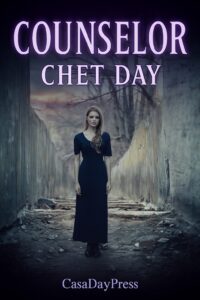A Writer’s Journey
Look, I’ll be honest with you. Cover design used to terrify me more than a blank page on deadline day. But not anymore. You see, with help from my AI buddy Claude, I’ve learned how to use AI for Kindle cover design.
For years, because I didn’t have the money, I created my own using Amazon’s cover creation tool. This approach generally birthed covers that looked like I’d assembled them during a caffeine crash using Microsoft Paint. Neither option of paying or self-creating had a lot of appeal, especially for an indie author watching every penny and trying to maintain some semblance of creative control over your work.
But recently, I stumbled onto something that changed the game entirely. Working with my AI collaborator Claude (yes, I work with an AI – more on that in a minute), we figured out how to create professional-quality Kindle covers using AI image generators. The process we developed for my psychological thriller Counselor was so successful, I had to share it with fellow writers who might be struggling with the same cover conundrum.
Read on for AI Kindle cover design techniques that work!
The Starting Point: Finding Your Perfect Image

The whole process began when I purchased from an online image store this absolutely haunting photograph – a woman in a long black dress standing in what looked like a deteriorating concrete tunnel or underpass. Bare winter trees were visible at the far end, and the lighting had this moody, psychological thriller vibe that made my writer brain immediately think “Yes! This is exactly what Counselor should feel like.”
Now, here’s the thing about finding source material: you don’t necessarily need the perfect image ready to go. What you need is a clear vision of the mood, atmosphere, and genre signals you want your cover to communicate. In my case, I knew I wanted something gothic, unsettling, and sophisticated enough to attract readers of literary psychological thrillers.
The image I found was horizontal, which presented our first challenge. Kindle covers need to be vertical. But that’s where AI collaboration comes in handy. Just describe what you want and let the technology work its magic to transform your vision into the right format.
Enter the AI Collaboration
Here’s where some of you might be thinking, “Wait, you work with an AI?”
Yes, I do. Claude and I have been collaborating on various writing and publishing projects for months now. Our work together has results in one of the most productive creative partnerships I’ve ever experienced. Not because the AI does all the creative work. No way. Rather, it serves as the ideal technical consultant and brainstorming partner that helps me translate creative vision into actionable specifications.
Think of it this way: I bring the artistic vision, genre knowledge, and publishing experience. Claude brings structured thinking, technical precision, and the ability to craft prompts that actually work with other AI tools. Together, we tackle projects that would cost me big bucks to outsource or take me weeks to figure out on my own.
For the cover project, my role was knowing exactly what emotional response I wanted from potential readers. Claude’s role was helping me translate that vision into technical specifications that would work with ChatGPT’s image generation capabilities.
The Technical Reality Check
This is where most DIY cover attempts go sideways, and honestly, where I would have crashed and burned without help.
Kindle covers aren’t just “make it look pretty and slap some text on it.” There are specific technical requirements that can make or break your book’s success:
- Dimensions: 1600 x 2560 pixels (that 5:8 ratio is crucial)
- Orientation: Vertical (seems obvious, but I’ve seen plenty of mistakes here)
- Resolution: 300 DPI minimum for professional quality
- File size: Under 50MB, ideally 5-10MB
- Thumbnail readability: Your cover has to work when it’s reduced to 500 pixels wide
That last point is critical and often overlooked. Your gorgeous full-size cover means nothing if potential readers can’t read the title when they’re browsing Amazon on their phones.
During our collaboration, Claude caught a major error I’d made in the initial specifications. I’d mixed up the aspect ratios and listed horizontal dimensions when we needed vertical. That kind of mistake would have sent me back to square one after waiting for the AI to generate the wrong format.
Crafting the Perfect Prompt
Here’s where the magic really happens, and where most people either nail it or waste hours generating unusable images.
The key is being incredibly specific about what you want while leaving room for the AI to work its creative magic. Our final prompt included:
Visual Elements: Detailed description of the atmospheric tunnel scene, the woman in the black dress, the mood and lighting
Technical Specifications: Exact dimensions, resolution, file format requirements
Typography Requirements: Specific placement for title, author name, and publisher, plus color specifications (we went with rich purple text to “pop” against the moody background)
Design Guidelines: Instructions for maintaining the psychological thriller aesthetic while ensuring professional quality and thumbnail readability
The trick is being precise enough that you get what you envision, but not so rigid that you strangle the AI’s ability to surprise you with something even better than you imagined.
The Iteration Process
I’m going to let you in on a little secret: we didn’t nail it on the first try.
Well, actually, we did nail it on the first try, but only because we went through several rounds of refining the prompt before we ever fed it to ChatGPT. Claude caught technical errors, suggested improvements to the visual descriptions, and helped me think through potential problems before they became actual problems.
This is where having a collaboration partner – whether it’s an AI, a designer friend, or another writer – becomes invaluable. Fresh eyes can spot issues you’ll miss when you’re deep in the creative process.
For example, I initially focused so heavily on the atmospheric mood that I almost forgot to specify font suggestions that would signal “psychological thriller” to browsers. Claude reminded me that genre expectations matter – readers need visual cues that help them immediately understand what kind of story they’re considering.
The Result That Made Me Do a Happy Dance
When the final cover came back, I literally said “Holy cow!” out loud in my home office.
The purple typography popped exactly like we’d envisioned, creating dramatic contrast against the moody background. The composition perfectly balanced the mysterious figure with readable text placement. Most importantly, it immediately communicated “psychological thriller with literary quality” – exactly what I needed to attract the right readers for Counselor.
The cover works beautifully at full size and remains completely readable as a thumbnail. It’s professional enough to compete with traditionally published books, but it has enough personality to stand out in crowded genre categories.
Total cost? Given the fact that I’m retired and living on beans and rice half the time, I used the free version of ChatGPT. Total time? Maybe two hours from initial concept to final cover, including all our prompt refinement work.
What This Means for Other Writers
Look, I’m not saying this approach will work for every book or every author. Some stories need custom illustration work that only human artists can provide. Some authors prefer the collaborative process of working directly with professional designers.
But for indie authors and old dudes like me who need professional-quality covers without the professional-designer budget, this AI-assisted approach opens up possibilities that simply didn’t exist a few years ago.
The key is understanding that you’re not replacing human creativity – you’re augmenting it. You still need to bring vision, judgment, and knowledge of your genre and audience. What AI provides is the technical execution and the ability to iterate quickly until you find something that works.
Practical Tips for Your Own Cover Project
If you decide to try this approach, here are the lessons I learned:
Start with mood, not details. Don’t get hung up on specific visual elements. Focus on the emotional response you want from potential readers.
Get the technical specs right from the beginning. Double-check those dimensions and requirements. Trust me on this one.
Be specific about typography. Font choice and text placement can make or break a cover’s effectiveness.
Test thumbnail readability. Resize your cover to 500 pixels wide and see if you can still read the title clearly.
Don’t be afraid to iterate. If the first result isn’t quite right, refine your prompt and try again.
Consider collaboration. Whether it’s an AI assistant, a fellow author, or a designer friend, fresh perspective makes everything better.
The truth is, creating professional covers used to be one of those publishing hurdles that separated the pros from the wannabes. Not because good covers require mystical artistic powers, but because they require technical knowledge, design software skills, and often significant financial investment.
AI tools are democratizing that process in ways that should excite any indie author who’s ever stared at their manuscript wondering how the hell they’re going to make it look professional enough to compete in the marketplace.
The collaboration Claude and I developed for Counselor is just one example of how writers can leverage these tools without losing creative control or breaking the bank. And honestly? I’m excited to see what other publishing challenges we can tackle together.
Because at the end of the day, anything that lets us spend more time writing and less time wrestling with technical obstacles is a win in my book.
Speaking of books, if you’re curious about the psychological thriller that inspired this cover collaboration adventure, “Counselor” tells the story of a disturbed school counselor who systematically destroys the lives of vulnerable students. It’s available wherever fine ebooks are sold, complete with that gorgeous purple-blazoned cover we sweated over.
Hey, I’m 77 and I’ve got stories…
Stories about what it’s like to navigate life at this age (spoiler: it’s weird, wonderful, and occasionally terrifying). And stories about collaborating with AI to write books in ways that would have seemed like science fiction when I started putting words on paper. Stories about the daily realities, unexpected surprises, and hard-won wisdom that comes from three-quarters of a century on this planet. If you’re curious about authentic aging, writing innovation, or just enjoy good storytelling from someone who’s been around the block, subscribe to my weekly newsletter “Old Man Still Got Stories.” I promise to make it worth your time.
